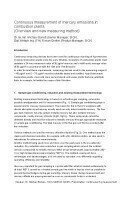Air Monitoring
Continuous measurement of mercury emissions in combustion plants (Overview and new measuring method)
Dec 12 2014
Author: Dr.rer.nat. Michael Boneß, Dipl.Wirtsch.Ing. (FH) Florian Greiter on behalf of Sick AG
Introduction
Continuous measuring devices have been used for continuous recording of Hg emissions in waste incineration plants since the early Nineties. Operators of combustion plants must maintain a 24-hour measured value of 30 μg/m³ mercury and a half-hourly average value of 50 μg/m³ in accordance with the 13th and 17th BImschV. In order to meet these requirements, measuring devices used for the measuring ranges 0 – 45 μg/m³ and 0 – 75 μg/m³ must be suitability tested and certified. Apart from waste incineration plants, more and more cement plants and power plants that use substitute fuels for example, fall within the scope of this Directive.
Sample gas conditioning, reduction and existing measurement technology
Existing measurement technology is based on extractive gas sampling, conversion, possibly amalgamation and UV measurement (Fig. 1). Sample gas conditioning plays a special role for mercury measurement. The reason for this is that UV analyzers with atomic absorption spectroscopy usually used can only detect metallic mercury. The flue gas does however not only contain metallic mercury but also oxidized mercury compounds, mainly mercury chloride (HgCl, HgCl2). These compounds cannot be detected directly and must be reduced to metallic mercury through appropriate measures in sample gas conditioning. The total mercury in the flue gas can first be recorded after this reduction.
Various methods are used for mercury chloride reduction (Fig. 2). One method uses the classic wet chemical reduction, for example, with a tin chloride solution, as also used in laboratories for reference measurements. Another method being used more and more over the past years is the so-called dry reduction. Dry reduction uses converters in gas sampling which convert the oxidized mercury compounds to metallic mercury either at low temperatures (approximately 250° C) or high temperatures (approximately 700° C). The methods used each have advantages and disadvantages, and are rated by operators very differently regarding operating, efficiency and reliability.
Digital Edition
AET 27.4 November 2023
November 2023
In This Edition Business News - Global sales of unique connected personal and area gas monitors reach over $2 million - nke Group announces the acquisition of Aquaread (UK) - Valeport suppo...
View all digital editions
Events
Nov 12 2023 Louisville, KY, USA
Nov 14 2023 Jakarta, Indonesia
Nov 14 2023 Valencia, Spain
Nov 14 2023 Karachi, Pakistan
Air Quality Measurement Methods and Tecnology
Nov 14 2023 Durham, NC, USA















